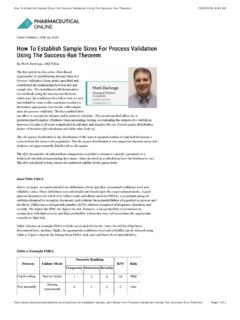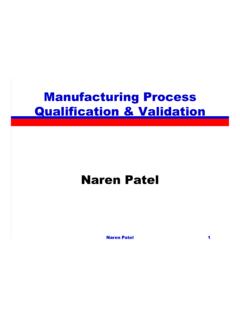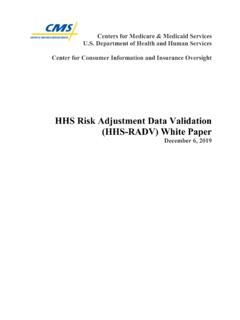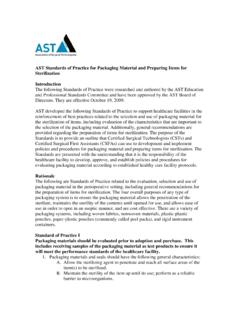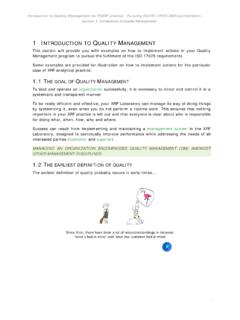Transcription of USING STABILITY TESTING TO DETERMINE SHELF LIFE
1 USING STABILITY TESTING TO DETERMINE SHELF LIFE CONTENTSWhat is SHELF Life? .. 1 How Do You DETERMINE the SHELF Life of a Product? .. 2 Real-Time STABILITY Tests .. 2 Accelerated Aging or Accelerated SHELF Life TESTING .. 3Is an Accelerated SHELF Life TESTING a Good Fit for Your Product? .. 3-4 ASTM-F1980 Time vs. Temperature .. 4 Tenney / Lunaire Environmental Test Chambers and Rooms Offer Superior SHELF Life TESTING for a Number of Industries .. 5 Products change over time as they sit in storage, but as long as their performance characteristics remain within the manufacturer s specifications, the products are considered stable. The phrase SHELF life refers to the length of time a product remains stable when stored under the manufacturer s recommended conditions.
2 Food manufacturers need to accurately DETERMINE the use by or best before dates for their products in order to meet strict regulations and to keep their brand and consumers safe. SHELF life is a product of physical, microbiological, and chemical processes, triggered by any one of a multitude of contributing factors. Manufacturers use real time STABILITY tests to establish a product s SHELF life. According to the Institute of Food Technologists (IFT) and the National Advisory Committee on Microbiological Criteria for Foods (NACMCF), SHELF -life is the amount of time that a food product is considered acceptable for consumption when stored at the appropriate storage conditions. When determining if a food product is acceptable for consumption, several factors including organoleptic properties (taste, order, texture, appearance), microbial spoilage, and chemical changes to the product during storage must be considered.
3 Almost all food, drug, and other consumed products require a stated expiration date in the USA. In addition, many other consumer and industrial product manufacturers define SHELF life to provide consumers an understanding of a products usable life at time of purchase. Also, these manufacturers use various packaging to extend storage conditions. This can be identified and verified USING SHELF life TESTING and accelerated SHELF life IS SHELF LIFE?1 The SHELF life of a product begins from the time the product is finished processing and is packaged. The time depends on factors like ingredients, manufacturing process , packaging, and typical storage are two main types of tests to establish SHELF life: real-time STABILITY tests and accelerated SHELF life TESTING . It should be noted that, in the food and drug industries, accelerated aging data is recognized by regulatory bodies as an acceptable means to generate data quickly, but this data is only accepted until those tests can be correlated to real time samples.
4 In other industries, accelerated aging is a tool that is very useful in product TESTING and understanding product limitations. HOW DO YOU DETERMINE THE SHELF LIFE OF A PRODUCT?REAL-TIME STABILITY TESTSM anufacturers typically use real-time STABILITY tests to DETERMINE the duration of time that the product will be effective for their customer s use. This provides consumers with what is known as the expiration date of a given product. Real-time STABILITY TESTING to DETERMINE SHELF life is rather straight forward store the product in a particular defined environment and note the point in time at which the product breaks down and becomes ineffective. This is done by taking a subset of the product samples in a STABILITY chamber and methodically TESTING for efficacy at pre-determined intervals until the product no longer exhibits its desired properties.
5 This clearly defines the products usable life. The storage temperature and humidity parameters are defined by different organizations depending on the type of product. For example, food and drug manufacturers have guidelines (ICH) to provide consistency. TESTING in this way ensures the product continues to meet the stringent quality, safety, and efficacy standards of the pharmaceutical industry, even after sitting on the SHELF for a long time or when exposed to various environments. Manufacturers of other products have other standards either defined by an industry group or that are company specific defined storage conditions. It should be noted that when doing this type of TESTING , often in addition to the product itself being tested, the packaging is also tested. This is especially true when the packaging is designed to enhance the products efficacy, longevity, or if the contents need to remain sterile.
6 Use real-time STABILITY tests to DETERMINE the duration of time that the product will be effective for [the] customer s use. 2 Accelerated SHELF life takes the climatic conditions to more extreme levels in order to compress required test time. This is done by applying the Arrhenius equation to DETERMINE the rate of acceleration of time based on increased temperatures. Accelerated aging uses aggravated conditions of heat, humidity, vibration, and other environmental stimuli to help DETERMINE the long-term effects of expected levels of stress in a much shorter time frame. These tests cycle through stages of applied stresses, causing materials to react as they would over a long period of storage or shipment to help verify SHELF -life and storage AGING OR ACCELERATED SHELF LIFE TESTINGIS AN ACCELERATED SHELF LIFE TESTING A GOOD FIT FOR YOUR PRODUCT?
7 SHELF stable and frozen products with a SHELF -life of six months or more are good candidates for accelerated SHELF life studies. Accelerated SHELF life studies are not recommended for all products, such as refrigerated products that spoil due to microbial growth. Each product has a specific mode of spoilage ( rancidity, moisture loss/gain, organoleptic changes), so applicable tests need to be tailored to the specific product. Most other products or durable goods can benefit from accelerated aging tests help DETERMINE product storage requirements as well as establish acceptable parameters for products and package expiration dates. Accelerated aging can also help DETERMINE the expected lifecycle of products and aging, oftentimes referred to as accelerated SHELF -life TESTING , is commonly used in the medical device industry to accelerate the effects of time on a sterile barrier packaging system to establish SHELF life parameters.
8 It is also commonly used for many other types of products. The accelerated aging process is based on the relationship of temperature and reaction rate where an increase in temperature increases the reaction applied in a package validation test plan (and within ANSI/AAMI/ISO 11607 guidelines), accelerated aging can result in a decreased time-to-market for a new product. For example, per the Arrhenius equation, a polymer product or one protected by polymer packaging that is subjected to weeks of Accelerated Aging at +55 C has similar aging characteristics as a sample aged at +25 C. One thing to be aware of is the limit of the product aging temperature. For polymer packaging, it is typically limited to +60 C or less due to the polymer material changes/breakdown at temperatures higher than 60 C.
9 This maximum temperature or point of degradation needs to be taken into consideration for other materials, as well. Reference ASTM F1980-16 ASTM-F1980 TIME VS. TEMPERATURE4 Accurate predictions of SHELF life rely on accurate TESTING results. Lunaire STABILITY Environmental Test Chambers and Rooms provide innovative engineering and design, robust construction, and superior performance that is needed to meet and exceed these requirements. The Lunaire steady state STABILITY reach in chambers include the CEO series, which offers a variety of temperature and humidity combinations in a number of workspace sizes, while the Lunaire SS series of steady state TESTING chambers offers high performance in workspaces of 10, 20, and 30 cubic feet. Lunaire also offers Steady State Environmental Walk-In Rooms for STABILITY TESTING , SHELF life TESTING , and accelerated life addition to SHELF life TESTING and accelerated SHELF life TESTING , Tenney and Lunaire manufacture high quality test chambers that can consistently meet nearly every temperature, humidity, altitude, and vacuum TESTING and processing requirements.
10 Tenney and Lunaire offer a number of environmental test chambers and rooms to meet a variety of TESTING , such as reliability TESTING , package TESTING , incubation, controlled walk-in and reach in cycling chambers, controlled temperature storage, accelerated aging, drying, burn in, and cold room applications for a number of pharmaceutical, medical, personal care, electronics, automotive, defense, industrial, research & development, and consumer products applications. TENNEY / LUNAIRE ENVIRONMENTAL TEST CHAMBERS AND ROOMS OFFER SUPERIOR SHELF LIFE TESTING FOR A NUMBER OF INDUSTRIESC ontact for more
